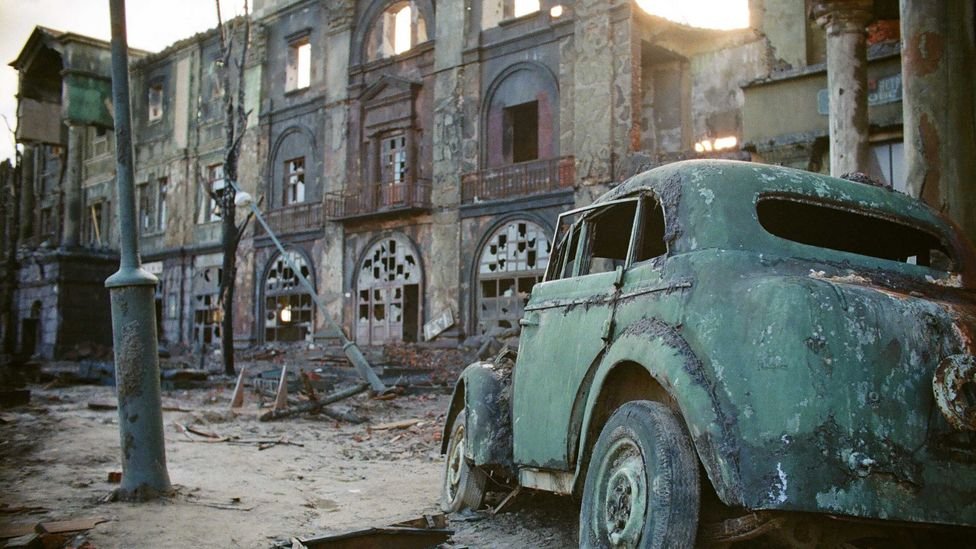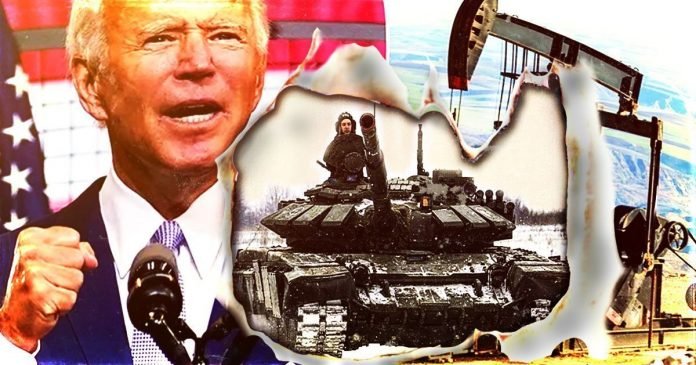Some possible precipitating factors are already in place. How the West reacts to them will determine the world’s future, says Rachel Nuwer.
This article By Rachel Nuwer was first published in 2017. Since then the world has turned upside down, the very ground we stand on has shifted several times from Covid to the US moving its sphere of influence and foreign policy from the Middle East and Afghanistan to the very heart of Europe and the ongoing war in Ukraine, however, the points and focus of this article are very relative today.
The political economist Benjamin Friedman once compared modern Western society to a stable bicycle whose wheels are kept spinning by economic growth. Should that forward-propelling motion slow or cease, the pillars that define our society – democracy, individual liberties, social tolerance and more – would begin to teeter. Our world would become an increasingly ugly place, one defined by a scramble over limited resources and a rejection of anyone outside of our immediate group. Should we find no way to get the wheels back in motion, we’d eventually face total societal collapse.
Such collapses have occurred many times in human history, and no civilisation, no matter how seemingly great, is immune to the vulnerabilities that may lead a society to its end. Regardless of how well things are going in the present moment, the situation can always change. Putting aside species-ending events like an asteroid strike, nuclear winter or deadly pandemic, history tells us that it’s usually a plethora of factors that contribute to collapse. What are they, and which, if any, have already begun to surface? It should come as no surprise that humanity is currently on an unsustainable and uncertain path – but just how close are we to reaching the point of no return?

While it’s impossible to predict the future with certainty, mathematics, science and history can provide hints about the prospects of Western societies for long-term continuation.
Safa Motesharrei, a systems scientist at the University of Maryland, uses computer models to gain a deeper understanding of the mechanisms that can lead to local or global sustainability or collapse. According to findings that Motesharrei and his colleagues published in 2014, there are two factors that matter: ecological strain and economic stratification. The ecological category is the more widely understood and recognised path to potential doom, especially in terms of depletion of natural resources such as groundwater, soil, fisheries and forests – all of which could be worsened by climate change.
Disaster comes when elites push society toward instability and eventual collapse by hoarding huge quantities of wealth and resources
That economic stratification may lead to collapse on its own, on the other hand, came as more of a surprise to Motesharrei and his colleagues. Under this scenario, elites push society toward instability and eventual collapse by hoarding huge quantities of wealth and resources, and leaving little or none for commoners who vastly outnumber them yet support them with labour. Eventually, the working population crashes because the portion of wealth allocated to them is not enough, followed by collapse of the elites due to the absence of labour. The inequalities we see today both within and between countries already point to such disparities. For example, the top 10% of global income earners are responsible for almost as much total greenhouse gas emissions as the bottom 90% combined. Similarly, about half the world’s population lives on less than $3 per day.
For both scenarios, the models define a carrying capacity – a total population level that a given environment’s resources can sustain over the long term. If the carrying capacity is overshot by too much, collapse becomes inevitable. That fate is avoidable, however. “If we make rational choices to reduce factors such as inequality, explosive population growth, the rate at which we deplete natural resources and the rate of pollution – all perfectly doable things – then we can avoid collapse and stabilise onto a sustainable trajectory,” Motesharrei said. “But we cannot wait forever to make those decisions.”

Unfortunately, some experts believe such tough decisions exceed our political and psychological capabilities. “The world will not rise to the occasion of solving the climate problem during this century, simply because it is more expensive in the short term to solve the problem than it is to just keep acting as usual,” says Jorgen Randers, a professor emeritus of climate strategy at the BI Norwegian Business School, and author of 2052: A Global Forecast for the Next Forty Years. “The climate problem will get worse and worse and worse because we won’t be able to live up to what we’ve promised to do in the Paris Agreement and elsewhere.”
While we are all in this together, the world’s poorest will feel the effects of collapse first. Indeed, some nations are already serving as canaries in the coal mine for the issues that may eventually pull apart more affluent ones. Syria, for example, enjoyed exceptionally high fertility rates for a time, which fueled rapid population growth. A severe drought in the late 2000s, likely made worse by human-induced climate change, combined with groundwater shortages to cripple agricultural production. That crisis left large numbers of people – especially young men – unemployed, discontent and desperate. Many flooded into urban centres, overwhelming limited resources and services there. Pre-existing ethnic tensions increased, creating fertile grounds for violence and conflict. On top of that, poor governance – including neoliberal policies that eliminated water subsidies in the middle of the drought – tipped the country into civil war in 2011 and sent it careening toward collapse.
Another sign that we’re entering into a danger zone is the increasing occurrence of ‘nonlinearities’, or sudden, unexpected changes in the world’s order
In Syria’s case – as with so many other societal collapses throughout history – it was not one but a plethora of factors that contributed, says Thomas Homer-Dixon, chair of global systems at the Balsillie School of International Affairs in Waterloo, Canada, and author of The Upside of Down. Homer-Dixon calls these combined forces tectonic stresses for the way in which they quietly build up and then abruptly erupt, overloading any stabilising mechanisms that otherwise keep a society in check.
The Syrian case aside, another sign that we’re entering into a danger zone, Homer-Dixon says, is the increasing occurrence of what experts call nonlinearities, or sudden, unexpected changes in the world’s order, such as the 2008 economic crisis, the rise of ISIS, Brexit, or Donald Trump’s election.

The past can also provide hints for how the future might play out. Take, for example, the rise and fall of the Roman Empire. By the end of the 100BC the Romans had spread across the Mediterranean, to the places most easily accessed by sea. They should have stopped there, but things were going well and they felt empowered to expand to new frontiers by land. While transportation by sea was economical, however, transportation across land was slow and expensive. All the while, they were overextending themselves and running up costs. The Empire managed to remain stable in the ensuing centuries, but repercussions for spreading themselves too thin caught up with them in the 3rd Century, which was plagued by civil war and invasions. The Empire tried to maintain its core lands, even as the army ate up its budget and inflation climbed ever higher as the government debased its silver currency to try to cover its mounting expenses. While some scholars cite the beginning of collapse as the year 410, when the invading Visigoths sacked the capital, that dramatic event was made possible by a downward spiral spanning more than a century.
Eventually, Rome could no longer afford to prop up its heightened complexities
According to Joseph Tainter, a professor of environment and society at Utah State University and author of The Collapse of Complex Societies, one of the most important lessons from Rome’s fall is that complexity has a cost. As stated in the laws of thermodynamics, it takes energy to maintain any system in a complex, ordered state – and human society is no exception. By the 3rd Century, Rome was increasingly adding new things – an army double the size, a cavalry, subdivided provinces that each needed their own bureaucracies, courts and defences – just to maintain its status quo and keep from sliding backwards. Eventually, it could no longer afford to prop up those heightened complexities. It was fiscal weakness, not war, that did the Empire in.
So far, modern Western societies have largely been able to postpone similar precipitators of collapse through fossil fuels and industrial technologies – think hydraulic fracturing coming along in 2008, just in time to offset soaring oil prices. Tainter suspects this will not always be the case, however. “Imagine the costs if we have to build a seawall around Manhattan, just to protect against storms and rising tides,” he says. Eventually, investment in complexity as a problem-solving strategy reaches a point of diminishing returns, leading to fiscal weakness and vulnerability to collapse. That is, he says “unless we find a way to pay for the complexity, as our ancestors did when they increasingly ran societies on fossil fuels.”

Also paralleling Rome, Homer-Dixon predicts that Western societies’ collapse will be preceded by a retraction of people and resources back to their core homelands. As poorer nations continue to disintegrate amid conflicts and natural disasters, enormous waves of migrants will stream out of failing regions, seeking refuge in more stable states. Western societies will respond with restrictions and even bans on immigration; multi-billion dollar walls and border-patrolling drones and troops; heightened security on who and what gets in; and more authoritarian, populist styles of governing. “It’s almost an immunological attempt by countries to sustain a periphery and push pressure back,” Homer-Dixon says.
Meanwhile, a widening gap between rich and poor within those already vulnerable Western nations will push society toward further instability from the inside. “By 2050, the US and UK will have evolved into two-class societies where a small elite lives a good life and there is declining well-being for the majority,” Randers says. “What will collapse is equity.”
Whether in the US, UK or elsewhere, the more dissatisfied and afraid people become, Homer-Dixon says, the more of a tendency they have to cling to their in-group identity – whether religious, racial or national. Denial, including of the emerging prospect of societal collapse itself, will be widespread, as will rejection of evidence-based fact. If people admit that problems exist at all, they will assign blame for those problems to everyone outside of their in-group, building up resentment. “You’re setting up the psychological and social prerequisites for mass violence,” Homer-Dixon says. When localised violence finally does break out, or another country or group decides to invade, collapse will be difficult to avoid.
Europe, with its close proximity to Africa, its land bridge to the Middle East and its neighbourly status with more politically volatile nations to the East, will feel these pressures first. The US will likely hold out longer, surrounded as it is by ocean buffers.

As time passes, some empires simply become increasingly inconsequential
On the other hand, Western societies may not meet with a violent, dramatic end. In some cases, civilisations simply fade out of existence – becoming the stuff of history not with a bang but a whimper. The British Empire has been on this path since 1918, Randers says, and other Western nations might go this route as well. As time passes, they will become increasingly inconsequential and, in response to the problems driving their slow fade-out, will also starkly depart from the values they hold dear today. “Western nations are not going to collapse, but the smooth operation and friendly nature of Western society will disappear, because inequity is going to explode,” Randers argues. “Democratic, liberal society will fail, while stronger governments like China will be the winners.”
Some of these forecasts and early warning signs should sound familiar, precisely because they are already underway. While Homer-Dixon is not surprised at the world’s recent turn of events – he predicted some of them in his 2006 book – he didn’t expect these developments to occur before the mid-2020s.
Western civilisation is not a lost cause, however. Using reason and science to guide decisions, paired with extraordinary leadership and exceptional goodwill, human society can progress to higher and higher levels of well-being and development, Homer-Dixon says. Even as we weather the coming stresses of climate change, population growth and dropping energy returns, we can maintain our societies and better them. But that requires resisting the very natural urge, when confronted with such overwhelming pressures, to become less cooperative, less generous and less open to reason. “The question is, how can we manage to preserve some kind of humane world as we make our way through these changes?” Homer-Dixon says.
Support Independent Journalism Today
Our unwavering dedication is to provide you with unbiased news, diverse perspectives, and insightful opinions. We're on a mission to ensure that those in positions of power are held accountable for their actions, but we can't do it alone. Labour Heartlands is primarily funded by me, Paul Knaggs, and by the generous contributions of readers like you. Your donations keep us going and help us uphold the principles of independent journalism. Join us in our quest for truth, transparency, and accountability – donate today and be a part of our mission!
Like everyone else, we're facing challenges, and we need your help to stay online and continue providing crucial journalism. Every contribution, no matter how small, goes a long way in helping us thrive. By becoming one of our donors, you become a vital part of our mission to uncover the truth and uphold the values of democracy.
While we maintain our independence from political affiliations, we stand united against corruption, injustice, and the erosion of free speech, truth, and democracy. We believe in the power of accurate information in a democracy, and we consider facts non-negotiable.
Your support, no matter the amount, can make a significant impact. Together, we can make a difference and continue our journey toward a more informed and just society.
Thank you for supporting Labour Heartlands









